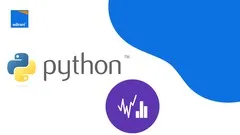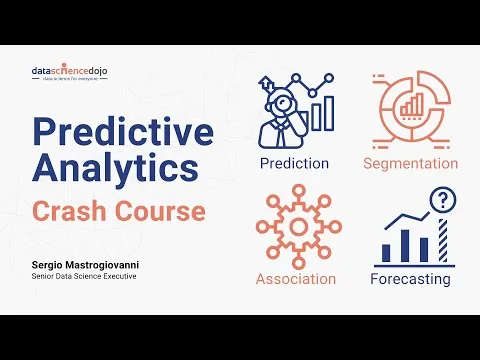
Predictive Prescriptive Analytics for Decision Making 
Learn how to build predictive and prescriptive models using numerical data in the course "Predictive Prescriptive Analytics for Decision Making." This course will teach you how to use prescriptive analytics to make better business decisions by analyzing raw data and considering factors such as possible scenarios, available resources, and past and current performance. You will also learn about time-series forecasting, optimization through linear programming, and the gradient descent algorithm. Ideal for professionals with 8 years of work experience, this course is perfect for engineers, software and IT professionals, project managers, business analysts, consultants, and entrepreneurs. ▼
ADVERTISEMENT
Course Feature
![]() Cost:
Cost:
Paid
![]() Provider:
Provider:
Udemy
![]() Certificate:
Certificate:
Paid Certification
![]() Language:
Language:
English
![]() Start Date:
Start Date:
2021-05-20
Course Overview
❗The content presented here is sourced directly from Udemy platform. For comprehensive course details, including enrollment information, simply click on the 'Go to class' link on our website.
Updated in [September 15th, 2023]
What does this course tell?
(Please note that the following overview content is from the original platform)
PREDICTIVE PRESCRIPTIVE ANALYTICS FOR BUSINESS DECISION MAKINGLEARN HOW TO BUILD PREDICTIVE AND PRESCRIPTIVE MODELS USING NUMERICAL DATAPrescriptive analytics can cut through the clutter of immediate uncertainty and changing conditions It can help prevent fraud limit risk increase efficiency meet business goals and create more loyal customersPrescriptive analytics is a type of data analytics the use of technology to help businesses make better decisions through the analysis of raw data Specifically prescriptive analytics factors information about possible situations or scenarios available resources past performance and current performance and suggests a course of action or strategy It can be used to make decisions on any time horizon from immediate to long termWhat will you Learn?Understand the difference between Cross sectional and Longitudinal dataDifferentiate between a prediction and forecasting problem scenario and apply these concepts towards data led decision makingUnderstand Parametric and Non Parametric modelling approach towards addressing the key tradeoff between Predictive accuracy and Explain- ability of modelsUse LPP towards building multiple [What if [ scenarios which are widely used in business decision makingConceptualize Gradient Descent Algorithm which is a key foundation for most of the widely used Machine learning algorithms to be introduced subsequentlyTop skills you will learnDevelop predictive and prescriptive models using numerical dataTime-series ForecastingOptimization through Linear ProgrammingGradient Descent and it's applicability in Machine LearningFramework towards business decisionsIdeal For1 : 8 yrs work experience- Engineering Math&Statistics&Programming background preferredTypical roles: Domain experts Engineers Software and IT Professionals ProjectManagers Business Analysts Consultants EntrepreneursEngineers with over 5 years of experience
We consider the value of this course from multiple aspects, and finally summarize it for you from three aspects: personal skills, career development, and further study:
(Kindly be aware that our content is optimized by AI tools while also undergoing moderation carefully from our editorial staff.)
What skills and knowledge will you acquire during this course?
During this course, the learner will acquire several skills and knowledge related to predictive and prescriptive analytics for decision making. They will understand the difference between cross-sectional and longitudinal data, and how to differentiate between prediction and forecasting problems. They will also learn how to apply these concepts towards data-led decision making.
The learner will gain an understanding of parametric and non-parametric modeling approaches, and how to address the tradeoff between predictive accuracy and explainability of models. They will also learn how to use linear programming to build multiple "what if" scenarios, which are widely used in business decision making.
Additionally, the learner will conceptualize the gradient descent algorithm, which is a key foundation for many machine learning algorithms. They will also learn about time-series forecasting and optimization through linear programming.
Overall, the learner will develop the skills to build predictive and prescriptive models using numerical data, and gain a framework for making business decisions. This course is ideal for individuals with 1-8 years of work experience, particularly those with an engineering, math, statistics, or programming background. Typical roles that would benefit from this course include domain experts, engineers, software and IT professionals, project managers, business analysts, consultants, and entrepreneurs.
How does this course contribute to professional growth?
This course on Predictive Prescriptive Analytics for Decision Making can greatly contribute to professional growth. By learning how to build predictive and prescriptive models using numerical data, individuals can enhance their decision-making abilities and make more informed choices in their professional roles.
One of the key benefits of this course is the understanding of the difference between cross-sectional and longitudinal data. This knowledge allows professionals to analyze data from different perspectives and make more accurate predictions and forecasts. By differentiating between prediction and forecasting problems, individuals can apply these concepts to real-world scenarios and make data-led decisions.
The course also covers the parametric and non-parametric modeling approaches, which address the tradeoff between predictive accuracy and explainability of models. This understanding is crucial in selecting the most appropriate modeling technique for a given situation, ensuring that the models developed are both accurate and understandable.
Additionally, the course teaches the use of Linear Programming (LP) to build multiple "what if" scenarios, which are widely used in business decision-making. This skill enables professionals to evaluate different scenarios and make informed choices based on the available resources, past performance, and current performance.
Furthermore, the course introduces the Gradient Descent Algorithm, which is a fundamental concept in machine learning. Understanding this algorithm provides a strong foundation for individuals to delve into various machine learning techniques and apply them to real-world business problems.
By completing this course, professionals will develop skills in predictive and prescriptive modeling using numerical data, time-series forecasting, optimization through linear programming, and the application of gradient descent in machine learning. These skills are highly valuable in today's data-driven business environment and can significantly contribute to professional growth.
Overall, this course is ideal for individuals with 8 years of work experience, particularly those with an engineering, math, statistics, or programming background. It is suitable for a range of roles, including domain experts, engineers, software and IT professionals, project managers, business analysts, consultants, and entrepreneurs. Engineers with over 5 years of experience can also benefit from this course and further enhance their professional growth.
Is this course suitable for preparing further education?
Yes, this course is suitable for preparing further education. It provides a comprehensive overview of predictive and prescriptive analytics, which are essential skills for making informed decisions in business. The course covers topics such as cross-sectional and longitudinal data, parametric and non-parametric modelling, linear programming, gradient descent, and machine learning. It is ideal for those with 8 years of work experience, engineering, math, statistics, and programming backgrounds, as well as domain experts, software and IT professionals, project managers, business analysts, consultants, and entrepreneurs.
Course Syllabus
Chapter 1 - Overview of Predictive Analytics
Chapter 2 - Simple Linear Regression and Multiple Linear Regression
Chapter 3 - Time Series Forecasting
Chapter 4 - Prescriptive Analytics -Gradient Descent
Chapter 5-Prescriptive Analytics-Linear Programming Problems
Chapter 6 -Business Decisions I
Chapter 7 -Business Decisions ..II
Course Provider

Provider Udemy's Stats at AZClass
Discussion and Reviews
0.0 (Based on 0 reviews)
Explore Similar Online Courses

Predictive Analytics on SAP Analytics Cloud

Introduction to Predictive Data Analytics

Python for Informatics: Exploring Information

Social Network Analysis

Introduction to Systematic Review and Meta-Analysis

The Analytics Edge

DCO042 - Python For Informatics

Causal Diagrams: Draw Your Assumptions Before Your Conclusions

Whole genome sequencing of bacterial genomes - tools and applications

Learning Predictive Analytics with Python

What is Predictive Analytics?


Start your review of Predictive Prescriptive Analytics for Decision Making